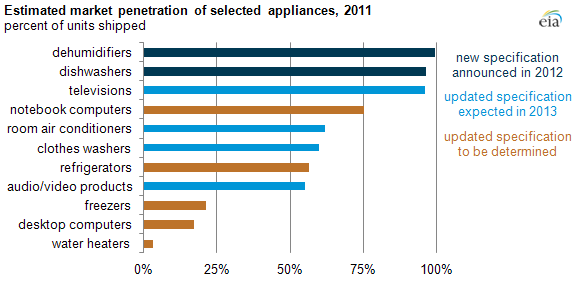Energy efficiency is making great gains in both home construction and appliances, according to date from the US Energy Information Agency.
Last year, 26% of all the new single-family homes in the US met voluntary Energy Star standards.
When the stats are in for 2012, those numbers will be higher. This year, 400 of the biggest US home builders pledged to use newly upgraded Energy Star standards for all new construction and new multifamily high-rise residential buildings are eligible as well, for the first time.
Earlier this year, EPA updated standards for home construction. To receive Energy Star designation, homes must use at least 15% less energy than those built to the 2009 International Energy Conservation Code.
Green-rated homes have a sales price that’s 9% higher than average similar homes and 80% of builders say energy efficient features are now pervasive in new homes.
And more than 10,000 high performance homes have been built that use 40% less energy than their conventional counterparts.
Appliances Too
Energy Star is also reaching strong penetration rates for appliances and consumer electronics products – almost 95% of some categories now bear the logo.
Because all dehumidifiers and dishwashers are now Energy Star, the Environmental Protection Agency made the standards more stringent this year. Specifications will be updated next year for televisions, room air-conditioners, clothes washers and some audio/video technologies, which have also reached high penetration rates.
Water heaters are relatively new to the program, which is why their market penetration is low.

LG Electronics USA reports that sales of products that have its "Most Efficient" Energy Star designation leapt 75% this year to 750,000 units.
More than 60 LG Electronics products carry that designation, including the most refrigerators and washing machines in the industry.
These purchases will save $150 million in utility costs over their lifetime and reduce greenhouse gas emissions by about 930 million pounds.
"Energy efficiency is a core consideration across the board when LG designs new products from washing machines and refrigerators to HDTVs and air conditioners," says John Taylor, vice president of public affairs for LG Electronics USA.
Energy Star, a joint program of the US Environmental Protection Agency and the U.S. Department of Energy, has existed since the early 1990s as a voluntary, market-based program identifying energy-efficient products.
The intention is to identify the top 25% most-efficient options within a product class at the date the specification goes into effect. Over time, market penetration of ENERGY STAR-labeled appliances increases, and when the market becomes well-saturated with those devices, the specifications are raised.
Now in its second year, EPA also recognizes the "Most Efficient" products in a category – the top 5%.
Some states and utilities offer rebates when people buy Energy Star products, such as Oregon and New Jersey, and others, like North Carolina and Missouri exempt them from a sales tax, reports IEA.
Use EPA’s Green Product Portal to find Energy Star products:

